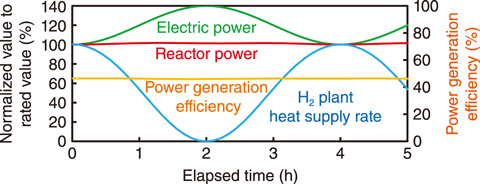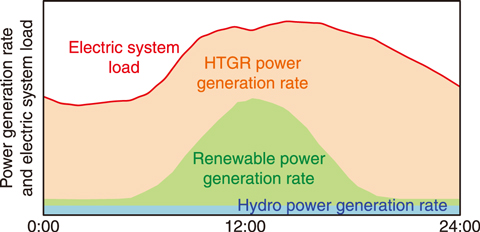
Fig.6-6 HTGR concept accomplishing economical hybrid operation with variable renewable electricity sources

Fig.6-7 Dynamic behavior of the HTGR plant during load-following operation in a long time-scale variation of renewable power generations

Fig.6-8 Example hybrid operation using HTGRs and renewable electricity sources
Wide-scale penetration of variable renewable electricity technologies, such as solar and wind energy, is expected in the near future to significantly reduce CO2 emissions and move toward a more sustainable electricity production. Due to the inherent stochasticity of many renewable sources, hydropower and fossil-based power plants have been required to balance the gaps between the supply and demand in the electric grid. However, using fossil fuel-based power plants are not a preferable option because these generators release massive amounts of CO2 into the atmosphere. Existing nuclear power plants are typically run in baseload mode to avoid any impact of power variation on components or power generation efficiency, which would lead to a decreased economic efficiency.
The development of an HTGR capable of offering economic CO2-free grid stability that has not been provided by other power generation technologies will promote its deployment in a carbon-constrained world. As a result of comprehensive review of unique HTGR characteristics, it was determined that a gas turbine can be used to compensate for seasonal and daily variations in renewable energy technologies without sacrificing power generation efficiency by controlling the coolant inventory because helium obeys the ideal gas law. In addition, the heat-to-power ratio in an HTGR can be adjusted at constant reactor power by varying the flow rate of a bypass line to a reactor and an intermediate heat exchanger due to the hydrogen and electricity cogeneration capability (Fig.6-6). Furthermore, the HTGR can change the power output on the order of seconds or minutes at a constant reactor power by using the inventory control with the aid of the large thermal capacity of the graphite reactor core. In summary, the electricity generation rate of an HTGR can be varied in accordance with various types of load variations induced by the use of intermittent renewable energy sources.
To demonstrate the efficacy of the operational strategies suggested above, numerical simulations were performed for load-following operations in long and short time-scale variations. The plant dynamics of the GTHTR300C, a commercial HTGR hydrogen and electricity cogeneration system designed by JAEA, were thus evaluated using a system analysis code based on RELAP5. Several improvements were made to the code to extend its applicability to HTGR cogeneration plants. The simulation results demonstrated that power generation rate of the GTHTR300C can be adjusted to correspond to the demand in a load-following scenario at constant reactor power and power generation efficiency without significant equipment modifications (Fig.6-7).
Overall, HTGRs were demonstrated to be capable of operating in a hybrid mode with variable renewable power generation and can thus contribute to the realization of a zero-emission power generation system (Fig.6-8).
(Hiroyuki Sato)